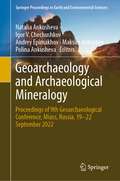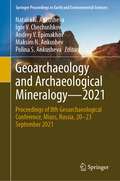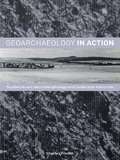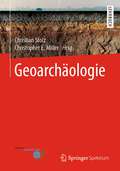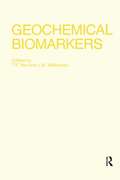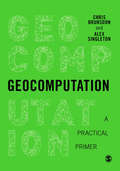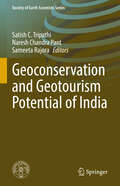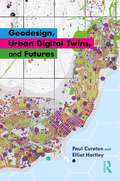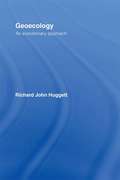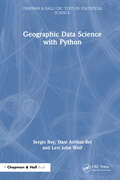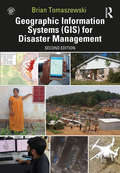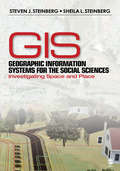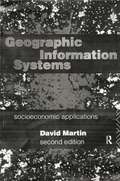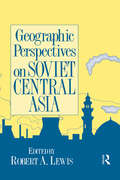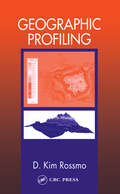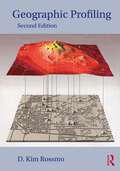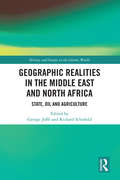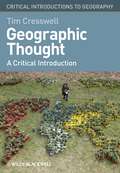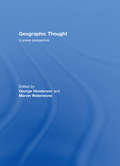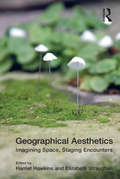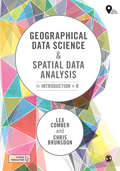- Table View
- List View
Geoarchaeology and Archaeological Mineralogy: Proceedings of 9th Geoarchaeological Conference, Miass, Russia, 19–22 September 2022 (Springer Proceedings in Earth and Environmental Sciences)
by Natalia Ankusheva Maksim Ankushev Igor V. Chechushkov Polina Ankusheva Andrey EpimakhovThe volume of Springer Proceedings in Geoarchaeology and Archaeological Mineralogy contains selected papers presented at the 9th Geoarchaeology Conference, which took place during September 19–22, 2022, at the South Urals Federal Research Center, the Ural Branch of the Russian Academy of Sciences, Miass, Russia. The Proceedings unite studies in the fields of archeometry, geoarchaeology, and ancient technologies, based on cases from northern Eurasia, and include archaeometallurgy, stone tools investigation, exploitation of geological resources in the past, bioarchaeology, residue analysis, pottery and lithics investigation, use of the GIS in archaeology. A study of non-organic materials, rocks, minerals, ores, metals, metallurgical slags is a special focus of the book. Many papers also use modern analytical methods of isotopic, chemical, and mineralogical analysis to study the composition and structure of ancient materials and the technological practices of past human populations of Modern Russia, Ukraine, Turkmenistan, Tajikistan, and Mongolia. The volume is intended for archaeologists, historians, museum workers, and geologists, as well as students, researchers from other disciplines, and the general public interested in the interdisciplinary research in the field of archaeology and archaeological materials, strategies and techniques of past quarrying, mining, metallurgy and lithic technologies at different chronological periods in Eurasian steppe and adjacent forest zone.
Geoarchaeology and Archaeological Mineralogy—2021: Proceedings of 8th Geoarchaeological Conference, Miass, Russia, 20–23 September 2021 (Springer Proceedings in Earth and Environmental Sciences)
by Igor V. Chechushkov Natalia N. Ankusheva Andrey V. Epimakhov Maksim N. Ankushev Polina S. AnkushevaThis book unites studies in the fields of archaeometry, geoarchaeology, and ancient technologies, based on cases from northern Eurasia, and includes archaeometallurgy, stone tools investigation, exploitation of geological resources in the past, bioarchaeology, residue analysis, pottery and lithics investigation, and use of the GIS in archaeology. The book of Springer Proceedings in Geoarchaeology and Archaeological Mineralogy contains selected papers presented at the 8th Geoarchaeology Conference, which took place during September 20–23, 2021, at the South Urals Federal Research Center, the Ural Branch of the Russian Academy of Sciences, Miass, Russia. A study of non-organic materials, rocks, minerals, ores, metals and metallurgical slags is a special focus of the book. Many papers also use modern analytical methods of isotopic, chemical, and mineralogical analysis to study the composition and structure of ancient materials and the technological practices of past human populations of Modern Russia, Ukraine, Turkmenistan, Tajikistan and Mongolia. The book is intended for archaeologists, historians, museum workers and geologists, as well as students, researchers from other disciplines and the general public interested in the interdisciplinary research in the field of archaeology and archaeological materials, strategies and techniques of past quarrying, mining, metallurgy and lithic technologies at different chronological periods in Eurasian steppe and adjacent forest zone.
Geoarchaeology in Action: Studies in Soil Micromorphology and Landscape Evolution
by Charles FrenchGeoarchaeology in Action provides much-needed 'hands on' methodologies to assist anyone conducting or studying geoarchaeological investigations on sites and in landscapes, irrespective of date, place and environment.The book sets out the essential features of geoarchaeological practice and geomorphological processes, and is deliberately aimed at the archaeologist as practitioner in the field. It explains the basics - what can be expected, what approaches may be taken, and what outcomes might be forthcoming, and asks what we can reasonably expect a micromorphological approach to archaeological contexts, data and problems to tell us.The twelve case studies are taken from Britain, Europe and the Near East. They illustrate how past landscape change can be discovered and deciphered whether you are primarily a digger, environmentalist or soil micromorphologist.Based on the author's extensive experience of investigating buried and eroded landscapes, the book develops new ways of looking at conventional models of landscape change. With an extensive glossary, bibliography and more than 100 illustrations it will be an essential text and reference tool for students, academics and professionals.
Geoarchäologie
by Christian Stolz Christopher E. MillerDas erste deutschsprachige Lehrbuch der Geoarchäologie bietet einen hervorragenden Einstieg in eine vielfältige Disziplin, die der Archäologie wie auch der Physischen Geographie und anderen Geowissenschaften zugewandt ist. Der Überblick über die breite methodische Vielfalt der Geoarchäologie macht dieses Buch zum verlässlichen Nachschlagewerk für Studierende, Forschende und Praktiker. Es gehört daher zum unverzichtbaren Handwerkszeug für alle, die sich mit umwelt- und kulturgeschichtlichen Fragen auseinandersetzen. Geoarchäologische Fragestellungen zählen zu den populärsten Themen innerhalb der beteiligten Fächer. Durch die Entschlüsselung von Geoarchiven mithilfe moderner Datierungs- und Analysemethoden und interdisziplinären Ansätzen gelingt es, frühere Kulturen innerhalb ihrer Umwelt zu verorten und vergangene Landschaften zu rekonstruieren. Gerade im Zeitalter des globalen Wandels erscheint es umso wichtiger, Zustände, Prozesse und Dynamiken der Vergangenheit zu verstehen, nicht zuletzt um daraus gewonnene Erkenntnisse auf zukünftige Entwicklungen anwenden zu können. Das Buch wurde von Wissenschaftlerinnen und Wissenschaftlern von über 30 verschiedenen Universitätsinstituten, Behörden und Forschungseinrichtungen erarbeitet. Die Herausgeber sind Sprecher des 2004 gegründeten Arbeitskreises Geoarchäologie. Ihre über 70 Mitautorinnen und Mitautoren gehören zu den kundigsten Fachleuten ihrer Themen im deutschsprachigen Raum und darüber hinaus.
Geochemical Biomarkers
by T.F. Yen J.M. MoldowanFirst Published in 1988. Routledge is an imprint of Taylor & Francis, an informa company.
Geocomputation: A Practical Primer
by Chris Brunsdon Alex David SingletonGeocomputation is the use of software and computing power to solve complex spatial problems. It is gaining increasing importance in the era of the ‘big data’ revolution, of ‘smart cities’, of crowdsourced data, and of associated applications for viewing and managing data geographically - like Google Maps. This student focused book: Provides a selection of practical examples of geocomputational techniques and ‘hot topics’ written by world leading practitioners. Integrates supporting materials in each chapter, such as code and data, enabling readers to work through the examples themselves. Chapters provide highly applied and practical discussions of: Visualisation and exploratory spatial data analysis Space time modelling Spatial algorithms Spatial regression and statistics Enabling interactions through the use of neogeography All chapters are uniform in design and each includes an introduction, case studies, conclusions - drawing together the generalities of the introduction and specific findings from the case study application – and guidance for further reading. This accessible text has been specifically designed for those readers who are new to Geocomputation as an area of research, showing how complex real-world problems can be solved through the integration of technology, data, and geocomputational methods. This is the applied primer for Geocomputation in the social sciences.
Geocomputation: A Practical Primer
by Chris Brunsdon Dr Alex David SingletonGeocomputation is the use of software and computing power to solve complex spatial problems. It is gaining increasing importance in the era of the 'big data' revolution, of 'smart cities', of crowdsourced data, and of associated applications for viewing and managing data geographically - like Google Maps. This student focused book: Provides a selection of practical examples of geocomputational techniques and 'hot topics' written by world leading practitioners. Integrates supporting materials in each chapter, such as code and data, enabling readers to work through the examples themselves. Chapters provide highly applied and practical discussions of: Visualisation and exploratory spatial data analysis Space time modelling Spatial algorithms Spatial regression and statistics Enabling interactions through the use of neogeography All chapters are uniform in design and each includes an introduction, case studies, conclusions - drawing together the generalities of the introduction and specific findings from the case study application - and guidance for further reading. This accessible text has been specifically designed for those readers who are new to Geocomputation as an area of research, showing how complex real-world problems can be solved through the integration of technology, data, and geocomputational methods. This is the applied primer for Geocomputation in the social sciences.
Geocomputation: A Practical Primer (Spatial Analytics and GIS)
by Chris Brunsdon Alex David SingletonGeocomputation is the use of software and computing power to solve complex spatial problems. It is gaining increasing importance in the era of the ‘big data’ revolution, of ‘smart cities’, of crowdsourced data, and of associated applications for viewing and managing data geographically - like Google Maps. This student focused book: Provides a selection of practical examples of geocomputational techniques and ‘hot topics’ written by world leading practitioners. Integrates supporting materials in each chapter, such as code and data, enabling readers to work through the examples themselves. Chapters provide highly applied and practical discussions of: Visualisation and exploratory spatial data analysis Space time modelling Spatial algorithms Spatial regression and statistics Enabling interactions through the use of neogeography All chapters are uniform in design and each includes an introduction, case studies, conclusions - drawing together the generalities of the introduction and specific findings from the case study application – and guidance for further reading. This accessible text has been specifically designed for those readers who are new to Geocomputation as an area of research, showing how complex real-world problems can be solved through the integration of technology, data, and geocomputational methods. This is the applied primer for Geocomputation in the social sciences.
Geocomputation: A Practical Primer (Spatial Analytics and GIS)
by Chris Brunsdon Alex David SingletonGeocomputation is the use of software and computing power to solve complex spatial problems. It is gaining increasing importance in the era of the ‘big data’ revolution, of ‘smart cities’, of crowdsourced data, and of associated applications for viewing and managing data geographically - like Google Maps. This student focused book: Provides a selection of practical examples of geocomputational techniques and ‘hot topics’ written by world leading practitioners. Integrates supporting materials in each chapter, such as code and data, enabling readers to work through the examples themselves. Chapters provide highly applied and practical discussions of: Visualisation and exploratory spatial data analysis Space time modelling Spatial algorithms Spatial regression and statistics Enabling interactions through the use of neogeography All chapters are uniform in design and each includes an introduction, case studies, conclusions - drawing together the generalities of the introduction and specific findings from the case study application – and guidance for further reading. This accessible text has been specifically designed for those readers who are new to Geocomputation as an area of research, showing how complex real-world problems can be solved through the integration of technology, data, and geocomputational methods. This is the applied primer for Geocomputation in the social sciences.
Geoconservation and Geotourism Potential of India (Society of Earth Scientists Series)
by Satish C. Tripathi Naresh Chandra Pant Sameeta RajoraIndia is blessed with great geological diversity as it has recorded more than 3.5 billion year’s history of evolution of Earth, some of the sites/sections are unique to the globe. The recent discovery of youngest ‘Meghalayan age’ from a limestone cave of Meghalaya is internationally recognised. The Indian rock record bears the signatures of various global geological events including evolution of life, mass extinction, making of Himalaya, meteoritic impact craters etc. Indian dinosaur 'Rajasaurus' created curiosity in the children. Interestingly, large number of geoheritage sites are associated with well-known cultural heritage sites and biodiversity hotspots. However, proper scientific details of geoheritage sites and their potential to develop as a geotourism hotspot has not been discussed. Geotourism potential of India in extensive but so far it has not attracted attention of authorities and agencies of the Tourism sector. The present book provides a platform for them to plan and explore. Development of geotourism will lead to conservation of geoheritage sites and both financial and scientific aspects will be covered.
Geodesign, Urban Digital Twins, and Futures
by Paul Cureton Elliot HartleyGeodesign, Urban Digital Twins, and Futures explores systems, processes, and novel technologies for planning, mapping, and designing our built environment. In a period of advancing urban infrastructure, technological autonomy in cities, and high-performance geographic systems, new capabilities, novel techniques, and streamlined procedures have emerged concurrently with climatic challenges, pandemics, and increasing global urbanisation. Chapters cover a range of topics such as urban digital twins, GeoBIM, geodesign and collaborative tools, immersive environments, gamification, and future methods. This book features over 100 international projects and workflows, five detailed case studies, and a companion website. In addition, this book examines geodesign as an agent for collaboration alongside futuring methods for imagining and understanding our future world.The companion website for this book can be accessed at http://geodesigndigitaltwins.com.
Geoecology: An Evolutionary Approach
by Richard HuggettAnimals, plants and soils interact with one another, with the terrestrial spheres, and with the rest of the Cosmos. On land, this rich interaction creates landscape systems or geoecosystems. Geoecology investigates the structure and function of geoecosystems, their components and their environment. The author develops a simple dynamic systems model, the `brash' equation, to form the conceptual framework for the book suggesting an `ecological' and `evolutionary' approach. Exploring internal of `ecological' interactions between geoecosystems and their near-surface environments - the atmosphere, hydrosphere, toposhere, and lithosphere - and external influences, both geological and cosmic, Geoecology presents geoecosystems as dynamic entities constantly responding to changes within themselves and their surroundings. An `evolutionary' view emerges of geoecological systems, and the animals, plants, and soils comprising them, providing a new way of thinking for the whole environmental complex and the rich web of interdependencies contained therein.
Geographic Data Science with Python (Chapman & Hall/CRC Texts in Statistical Science)
by Sergio Rey Dani Arribas-Bel Levi John WolfThis book provides the tools, the methods, and the theory to meet the challenges of contemporary data science applied to geographic problems and data. In the new world of pervasive, large, frequent, and rapid data, there are new opportunities to understand and analyze the role of geography in everyday life. Geographic Data Science with Python introduces a new way of thinking about analysis, by using geographical and computational reasoning, it shows the reader how to unlock new insights hidden within data. Key Features: ● Showcases the excellent data science environment in Python. ● Provides examples for readers to replicate, adapt, extend, and improve. ● Covers the crucial knowledge needed by geographic data scientists. It presents concepts in a far more geographic way than competing textbooks, covering spatial data, mapping, and spatial statistics whilst covering concepts, such as clusters and outliers, as geographic concepts. Intended for data scientists, GIScientists, and geographers, the material provided in this book is of interest due to the manner in which it presents geospatial data, methods, tools, and practices in this new field.
Geographic Information Systems (GIS) for Disaster Management
by Brian TomaszewskiNow in its second edition, Geographic Information Systems (GIS) for Disaster Management has been completely updated to take account of new developments in the field. Using a hands-on approach grounded in relevant GIS and disaster management theory and practice, this textbook continues the tradition of the benchmark first edition, providing coverage of GIS fundamentals applied to disaster management. Real-life case studies demonstrate GIS concepts and their applicability to the full disaster management cycle. The learning-by-example approach helps readers see how GIS for disaster management operates at local, state, national, and international scales through government, the private sector, non‐governmental organizations, and volunteer groups. New in the second edition: a chapter on allied technologies that includes remote sensing, Global Positioning Systems (GPS), indoor navigation, and Unmanned Aerial Systems (UAS); thirteen new technical exercises that supplement theoretical and practical chapter discussions and fully reinforce concepts learned; enhanced boxed text and other pedagogical features to give readers even more practical advice; examination of new forms of world‐wide disaster faced by society; discussion of new commercial and open-source GIS technology and techniques such as machine learning and the Internet of Things; new interviews with subject-matter and industry experts on GIS for disaster management in the US and abroad; new career advice on getting a first job in the industry. Learned yet accessible, Geographic Information Systems (GIS) for Disaster Management continues to be a valuable teaching tool for undergraduate and graduate instructors in the disaster management and GIS fields, as well as disaster management and humanitarian professionals. Please visit http://gisfordisastermanagement.com to view supplemental material such as slides and hands-on exercise video walkthroughs. This companion website offers valuable hands-on experience applying concepts to practice.
Geographic Information Systems for the Social Sciences: Investigating Space and Place
by Steven J. Steinberg Sheila L. SteinbergGeographic Information Systems for the Social Sciences: Investigating Space and Place is the first book to take a cutting-edge approach to integrating spatial concepts into the social sciences. In this text, authors Steven J. Steinberg and Sheila L. Steinberg simplify GIS (Geographic Information Systems) for practitioners and students in the social sciences through the use of examples and actual program exercises so that they can become comfortable incorporating this research tool into their repertoire and scope of interest. The authors provide learning objectives for each chapter, chapter summaries, links to relevant Web sites, as well as suggestions for student research projects.
Geographic Information Systems: Socioeconomic Applications
by David MartinThis second edition of Geographic Information Systems builds on the strengths of the first, and incorporates important recent advances in GIS development and major new socioeconomic datasets including new census data. Martin presents an accessible introduction to the history, principles and techniques of GIS, with a unique focus on socioeconomic applications. This non-technical volume addresses the needs of students and professionals who must understand and use GIS for the first time.
Geographic Perspectives on Soviet Central Asia
by Robert A. LewisIn a unique survey, based on new census data, Geographic Perspectives on Soviet Central Asia highlights the region's geographic, economic and ecological problems since 1945. Painting a grim picture, this book investigates how the combination of rapid population growth and declining per capita investment is causing economic conditions to slide in rural areas and encouraging an ecological catastrophe. The authors discuss the effects of low rural out-migration, and show that at current growth rates the rural working-age population will double with each generation. Unprecedented in a developed country, this is causing the region to become more rather than less rural. Soviet Central Asia is an area of low productivity, and the book considers the lack of support from Soviet central government to the region. Wishing to maximise their return to capital and labour, the government is concentrating its investment in the European West and directing insufficient funds for a growing workforce in Central Asia. Soviet Central Asia also faces grave ecological problems; the declining level of the Aral Sea, extensive soil salinization and water pollution, all largely due to past attempts at irrigation. The authors consider the effect of these disasters on the area, and look to future possibilities in this very important region of the world.
Geographic Profiling
by D. Kim RossmoAs any police officer who has ever walked a beat or worked a crime scene knows, the street has its hot spots, patterns, and rhythms: drug dealers work their markets, prostitutes stroll their favorite corners, and burglars hit their favorite neighborhoods. But putting all the geographic information together in cases of serial violent crime (murder, rape, arson, bombing, and robbery) is highly challenging. Just ask the homicide detectives of the Los Angeles Police Department who hunted the Hillside Stranglers, or law enforcement officers in Louisiana who tracked the brutal South Side rapist.Geographic Profiling introduces and explains this cutting-edge investigative methodology in-depth. Used to analyze the locations of a connected series of crimes to determine the most likely area of offender residence, geographic profiling allows investigators and law enforcement officers to more effectively manage information and focus their investigations.This extensive and exhaustive work explains geographic profiling theories and principles, and includes an extensive review of the literature and research in the areas of criminal profiling, forensic behavioral science, serial violent crime, environmental criminology, and the geography of crime. For investigators and police officers deployed in the field, as well as criminal analysts, Geographic Profiling is a "must have" reference.
Geographic Profiling
by D. Kim RossmoGeographic Profiling explores this cutting‑edge investigative methodology for determining the most probable area of an offender’s residence by analyzing the locations of a series of connected crimes. Geoprofiling allows police detectives and law enforcement officers to prioritize suspects, focus their investigations, and manage information overload. This extensive and exhaustive work explains the underlying theories and operational principles of the methodology. To provide context, extensive reviews of the research on serial murder, rape, and arson, stranger child murder, behavioral/psychological profiling, linkage analysis, and the geography of crime are included.As any police officer who has walked a beat or worked a crime scene knows, streets have hot spots, patterns, and rhythms. Understanding the varied geographic information in a crime series can be challenging. Renowned expert Kim Rossmo explains the concepts and applications of geographic profiling, and in this second edition updates his groundbreaking book with informative and engaging figures, tables, and examples. A range of applications are discussed including suspect prioritization, database searches, tactical response plans, missing person investigations, clandestine grave identification, and the role of geography in wrongful conviction reviews. Dr. Rossmo discusses the nature of police inquiries, criminal evidence, investigative challenges and failures, and more. The book explores the application of geographic profiling to violent and property crime, single offenses, epidemiology, counterterrorism/insurgency, and even earthquake epicenter and pirate base prediction. Fascinating new case studies include the Golden State Killer, Operation Lynx, the Zodiac Killer, the Lindbergh baby kidnapping, the DC Snipers, and the Austin Midnight Assassin.Geographic Profiling is a must‑have reference for detectives, crime analysts, and law enforcement officers who want to follow the geographic clues in their cases. Its clear presentation makes it ideal for college courses, police training, university scholars, and students of true crime.
Geographic Realities in the Middle East and North Africa: State, Oil and Agriculture (History and Society in the Islamic World)
by George Joffé; Richard SchofieldCelebrating the work of Keith McLachlan, a well-known and much-admired geographer of the Middle East and North Africa, this book combines three interrelated topics that define the region. The Middle East has been integral to the growth of the global oil industry, an aspect of its evolution since 1908 which has had profound geopolitical implications as well. The territory was also the arena for the last European experiment in colonialism, a development that has left its legacy even today. And, historically, it has been the location of the great hydraulic civilisations of Egypt and Mesopotamia yet is still dependent on the flow of its two major river systems – the Nile and the Tigris-Euphrates – in an era of impending climate crisis. These themes form the essence of themes that are discussed in the chapters that follow. Keith McLachlan played a significant role in our understanding of these themes and of their effects in the contemporary world, as the comments of those who worked with him and have contributed towards this book reveal. Examining agriculture, oil and state construction, this volume offers an insight into how the contemporary Middle East was constructed after the collapse of the Ottoman Empire. It is a key resource for scholars and students interested in geopolitics and the geography of the Middle East.
Geographic Thought: A Critical Introduction (Critical Introductions to Geography)
by Tim CresswellThis engaging and accessible introduction to geographic thought explores the major thinkers and key theoretical developments in the field of human geography. Covers the complete range of the development of theoretical knowledge of the field, from ancient geography to contemporary non-representational theory Presents theories in an accessible manner through the author's engaging writing style Examines the influence of Darwin and Marx, the emergence of anarchist geographies, the impact of feminism, and myriad other important bodies of thought Stresses the importance of geographic thought and its relevance to our understanding of what it is to be human, and to the people, places, and cultures of the world in which we live
Geographic Thought: A Praxis Perspective
by George Henderson Marvin WaterstoneWithout social movements and wider struggles for progressive social change, the field of Geography would lack much of its contemporary relevance and vibrancy. Moreover, these struggles and the geographical scholarship that engages with them have changed the philosophical underpinnings of the discipline and have inflected the quest for geographical knowledge with a sense not only of urgency but also hope. This reader, intended for advanced undergraduate and beginning graduate courses in Geographic Thought, is at once an analysis of Geography’s theoretical and practical concerns and an encounter with grounded political struggles. This reader offers a fresh approach to learning about Geographic Thought by showing, through concrete examples and detailed editorial essays, how the discipline has been forever altered by the rise of progressive social struggles. Structured to aid student understanding, the anthology presents substantive main and part introductory essays and features more than two dozen unabridged published works by leading scholars that emphatically articulate geographic thought to progressive social change. Each section is introduced with an explanation of how the following pieces fit into the broader context of geographic work amidst the socially progressive struggles that have altered social relations in various parts of the world over the last half-century or so. Doubly, it places this work in the context of the larger goals of social struggles to frame or reframe rights, justice, and ethics. Geographic Thought provides readers with insights into the encounters between scholarship and practice and aims to prompt debates over how social and geographical knowledges arise from the context of social struggles and how these knowledges might be redirected at those contexts in constructive, evaluative ways. The reader is unique not only in knowing Geographic Thought through its progressive political attachments, instead of through a series of abstract "isms", but in gathering together salient works by geographers as well as scholars in cognate fields, such as Nancy Fraser, Chantal Mouffe, Iris Marion Young, and Jack Kloppenberg, whose own engagements have proved lasting and influential. For researchers and students interested in the connections between theoretically informed work and the possibilities for bettering people’s everyday lives, this book provides an innovative and compelling argument for why Geographic Thought is valuable and necessary.
Geographical Aesthetics: Imagining Space, Staging Encounters
by Elizabeth StraughanGeographical Aesthetics places the terms 'aesthetics' and 'geography' under critical question together, responding both to the increasing calls from within geography to develop a 'geographical aesthetics', and a resurgence of interdisciplinary interest in conceptual and empirical questions around geoaesthetics, environmental aesthetics, as well as the spatialities of the aesthetic. Despite taking up an identifiable role within the geographical imagination and sensibilities for centuries, and having what is arguably a key place in the making of the modern discipline, aesthetics remains a relatively under-theorized field within geography. Across 15 chapters Geographical Aesthetics brings together timely commentaries by international, interdisciplinary scholars to rework historical relations between geography and aesthetics, and reconsider how it is we might understand aesthetics. In renewing aesthetics as a site of investigation, but also an analytic object through which we can think about worldly encounters, Geographical Aesthetics presents a reworking of our geographical imaginary of the aesthetic.
Geographical Data Science and Spatial Data Analysis: An Introduction in R (Spatial Analytics and GIS)
by Lex Comber Chris BrunsdonWe are in an age of big data where all of our everyday interactions and transactions generate data. Much of this data is spatial – it is collected some-where – and identifying analytical insight from trends and patterns in these increasing rich digital footprints presents a number of challenges. Whilst other books describe different flavours of Data Analytics in R and other programming languages, there are none that consider Spatial Data (i.e. the location attached to data), or that consider issues of inference, linking Big Data, Geography, GIS, Mapping and Spatial Analytics. This is a ‘learning by doing’ textbook, building on the previous book by the same authors, An Introduction to R for Spatial Analysis and Mapping. It details the theoretical issues in analyses of Big Spatial Data and developing practical skills in the reader for addressing these with confidence.
Geographical Data Science and Spatial Data Analysis: An Introduction in R (Spatial Analytics and GIS)
by Lex Comber Chris BrunsdonWe are in an age of big data where all of our everyday interactions and transactions generate data. Much of this data is spatial – it is collected some-where – and identifying analytical insight from trends and patterns in these increasing rich digital footprints presents a number of challenges. Whilst other books describe different flavours of Data Analytics in R and other programming languages, there are none that consider Spatial Data (i.e. the location attached to data), or that consider issues of inference, linking Big Data, Geography, GIS, Mapping and Spatial Analytics. This is a ‘learning by doing’ textbook, building on the previous book by the same authors, An Introduction to R for Spatial Analysis and Mapping. It details the theoretical issues in analyses of Big Spatial Data and developing practical skills in the reader for addressing these with confidence.
